Within weeks newborn infants start to reach, for and explore with their hands, and interesting objects that catch their attention and by 8 months when they start to sit they have developed quite sophisticated ability for sustained attention to a task and the ability to manipulate toys using a full range of hand actions.
This development of sustained attention and visual and manual exploration of toys is strongly influenced by the infant’s social environment. A responsive and rich environment which provides many opportunities that are just right for the infant’s level of development promotes optimal development of attention and fine motor skills.
This is particularly true for infants who are born preterm and those who are risk for developmental delay. For these infants early and responsive intervention to promote social, attention and fine motor skills is very important for ensuring optimal development.
Why it is very important to pay attention to the development of hand (fine motor) abilities
Long term follow up studies have shown that preterm infants have a greater risk of developing attention and fine motor problems when they enter school. This is true even for infants who are only 5-6 weeks preterm (often referred to as later preterm). Early intervention has been shown to reduce this risk.
Early intervention has also been shown to improve hand function (fine motor control) in Infants at risk for developing cerebral palsy (hemiplegia)
Below I have provided a list of the social and hand (fine motor) abilities as they appear during the first year. Use this to track your infant's progress.
More information fine motor development
How infants use their hands to grow their brains
How an enriched environment promotes optimal development
Importance of face-to-face conversations
From birth infants are able to imitate other people’s mouth movements and soon start to mirror the expressions on their caregiver’s faces.
Infants love to have conversations with their caregivers. Mothers are very good at setting up turn taking in these conversations: they say something and then give the infant a chance to respond. By 3-4 months infants are adding their own voice to the conversation as they coo and gurgle in response. These conversations provide the infant with their first experience of sustaining their attention on a task for minutes at a time.
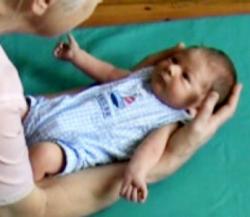
Reaching, grasping and manipulation
Within weeks newborn infants start to reach towards their carer’s faces and interesting objects within reach. Early reaching is a bit of a hit and miss affair, but soon the infant manages to grasp and explore toys that are suspended within easy reach.
At 3-4 months infants are able to hold the head steady in the midline and bring the hands together to hold and explore toys. What is quite remarkable is how, by this age, infants have developed the ability to pay careful and sustained attention to what they are doing with their hands: they prod, grasp, pull, and push the toy.
This exploration of toys teaches them a great deal about the relationship between what things look like, how they feel and how they respond to being manipulated.
Lots of experience with manipulating toys also provides the brain and the hand muscles with the experience they needs to control the movements of the fingers for the basic grasping actions

Early action: newborn to sitting
Newborn moments of repose and visual contact
Hands lightly fisted when lying quietly.
Looks intently at interesting objects - this is sometimes called visual reaching.
Visually tracks moving toy.


Looks with interest at caregivers face
Responds to caregivers voice. Will imitate mouth movements if prompted by caregiver.

Swipes at toys in reaching distance
Fingers are extended.
Sometimes manages to grasp toy.


Looks at own hands with great interest
Also watches hands of social companion.


Brings both hands to mouth
From 2-3 months infants can hold their heads steady in the mid-ling and bring their hands to their mouths.

Watches and reaches towards caregiver's face
Faces interest infants. Infants love to have conversations with caregivers.

Reaches for, feels and grasps toys with two hands
From about 3 months infants start to reach for toys within easy reaching distance. Hand not shaped to match the toy. Grasp is still hit and miss.


Uses fingers to explore a toy
Watches own actions carefully - this helps the infant to make connections in the brain between what he sees and what he feels.

Holds a toy in one hand briefly
Will hold and shake a rattle when it is placed in the hand. Grip is not secure. Drops toy quickly.

Sitting provides new opportunities
Inspecting and exploring toys
Opens and closes hands repeatedly when exploring a toy
Infants take particular delight in playing with flaps and labels on toys.


Grips small flat objects between thumb and forefinger
Notice how Roan (9 months) carefully positions the hand in readiness for grasping the flap on the toy.


Spends time exploring a new toy using two hands
Infants take time to inspect a new toy using both hands. They turn the toy over, turn it around, shake it and bang it on hard surface, taste it.
They also watch their own hand actions and visually inspect the toy with sustained attention.


Visually inspects a toy - turns it over and around
The infant looks at the toy with great interest , turning it around and inspecting it from all angles.
This visual exploration is important for making the connections in the brain that link what the infant sees to how the toy feels and behaves and also to the hand movement that are used to grasp and move the toy.


Adjusts shape and position of hand ready for grasping
Here you see how Will aged 10 months opens the fingers and aligns the hand in readiness for grasping the toy with the left hand.
At this age the hand will still open a lot more than needed for the action.


Shakes a toy to discover if it makes a noise
If the toy does not make a noise, the infant will usually stop the shaking action.
If the toy does make a noise, the infant will shake it several times before continuing to explore the toy in different ways.


Mouths a toy briefly to explore texture and taste
At 8 - 10 months the infant will still spend a little time exploring the taste and texture of a toy with the mouth. However this is usually quite brief and the infant quickly moves on the exploring the toy in different ways.

Passes toy from one hand to the other
Infants pass toys from one hand to the other repeatedly.
This is important for learning to use the two hands together, including moving the hands to the right place at the tight time.


Approaches and picks up larger object with two hands
Infant quickly learn when an object needs two hands for lifting.


Shaking, banging and drumming
Shakes a toy that makes a noise
Spends time shaking the toy in different ways to explore how different movements change the sound that is produced by the shaking action.
Stops and starts, speeds up, slows down and changes the direction of movements, changes hands.

Bangs toys on a hard surface
Vigorously bangs toys on a hard surface to discover if it makes a noise. Toys that produce a satisfying sound are banged repeatedly.


Bangs two blocks together
Picks up small hard toys such as blocks and bangs them together repeatedly.
The accuracy of the banging action improves over tome.


Drums with hands on hard surfaces that make a pleasing noise.
Bangs an open hand against a flat surface that produces an interesting sound. Explores drumming with one hand or both hands together.
Drumming is usually done in response to a demonstration by a play partner.


Takes turns in a drumming game with a play partner
The infant watches and copies the actions of a play partner who initiates the game. Infants are sensitive to turn taking.

Knocking over and building towers
Knocks over towers and other tall toys


Stacks two or three blocks or tubs to make a tower

Drop, throw, hide and look
Drops toys over side of feeding chair - watches them land.
This action teaches the infant a great deal about what happens when a toy falls onto a hard surface: What sort of noise does it make, does it bounce and roll?
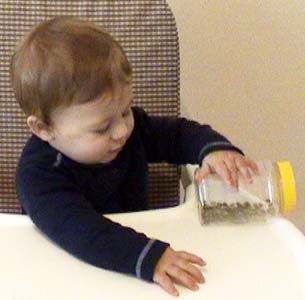

Throws toys backwards and then looks for them
This seems to be a favorite game for infants.


Tipping out and unpacking
Reaches into a container to retrieve a toy
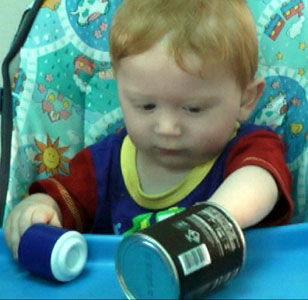

Tips toys out of a box or tub


Packing in and posting
Packs toys into a container
Holds toy over the opening and releases it.

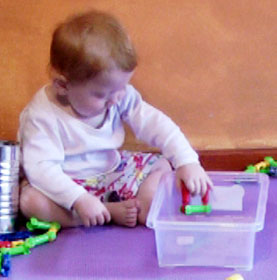
Posts a ball through a round hole in a box
Infants love posting games.

Posts a rod into a hole
This is more difficult than posting a ball into a round hole. The stick needs to aligned at right angles to the hole to fit through. Short rods are easier than longer rods.


Taking things apart and fitting them together
Takes lids off and puts them on again

 1
1
Takes apart a toy egg or tub
This requires a strong grip and forceful pulling action. Fitting them together again requires precision in matching the pieces.


Grasp and pull
Pulls toys apart
Knows how to grasp firmly and pull hard to pull a toy apart.

Pulls on a cloth to bring a toy nearer

Imitation and following instructions
Copies simple arm action
Imitates caregiver's everyday actions
Pretends to talk on the phone. Uses a lid as a hat.


Watches a demonstration and copies the action

Copies a complex action on a toy.
Here I show Roan how to pull a toy apart.
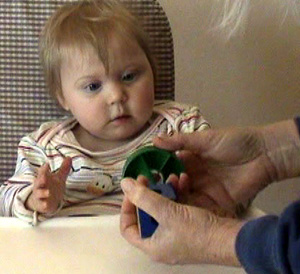

|
For Subscribers: PDF Download |
![]()
